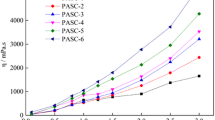Abstract
Through ultrasonic assisted radical polymerization, hydrophobically associating polyacrylamide (U-HAPAM) was prepared by acrylamide (AM), 2-acrylamido -2- methyl propane sulfonic acid (AMPS), and long-aliphatic-chain hydrophobic monomer octadecyl acrylate (ODA). The effects of ultrasonic frequency power on total monomer conversion, relative molecular mass and the aqueous solution behavior were discussed. The results showed that, when the ultrasonic power was 120 W, there was a good thickening ability, total monomer conversion was 76.36 %, relative weight-average molecular mass was 72500, the critical association mass concentration (C*) was 0.27 wt% and there were good intermolecular hydrophobically associating interactions in the copolymer aqueous solution. U-HAPAM was pseudoplastic fluid; the associating behavior of the U-HAPAM had apparent effects on the dynamic moduli (G′and G″) and the apparent average aggregate size (d*). When mass concentration of copolymer (Cm) was 0.40 wt%, the apparent viscosity attained 453.6 mPa·s. The viscosity retention index (VRI) was 60.99 % as the temperature reached 80 °C. The apparent viscosity of U-HAPAM in mineralized water was increased towards 502.9 mPa·s as the degree of mineralization (M) was 19334 mg/L. Under the effect of ultrasounds, the ODA was effectively introduced into U-HAPAM without micromolecule emulsifier, which endowed the copolymer good solution properties.








Similar content being viewed by others
References
Zhang Y, Wu F, Li M (2005) Novel approach to synthesizing hydrophobically associating copolymer using template copolymerization: the synthesis and behaviors of acrylamide and 4-(ω-Propenoyloxyethoxy) benzoic acid copolymer. J Phys Chem B 47:22250–22255
Cram SL, Brown HR, Spinks GM (2005) Hydrophobically modified dimethylacrylamide synthesis and rheological behavior. Macromolecules 7:2981–2989
Charpentier VD, Merle L (2005) Rheological properties of hydrophobically modified carboxymethylcelluloses. Carbohyd Polym 60:87–94
Wever DAZ, Picchioni F (2011) Polymers for enhanced oil recovery: a paradigm for structure–property relationship in aqueous solution. Prog Polym Sci 36:1558–1628
Zhang YB, Wu C, Fang Q (1996) A light-scattering study of the aggregation behavior of fluorocarbon-modified polyacrylamides in water. Macromolecules 29:2494–2497
Leibler L, Rubinstein M (1991) Dynamics of reversible networks. Macromolecules 24:4701–4707
Goodwin JW, Hugues RW (1997) Particle interactions and dispersion rheology. ACS Symp Ser 663:94–125
Volpert E, Selb J, Candau F, Green N, Argillier JF, Audibert A (1998) Adsorption of hydrophobically associating polyacrylamides on clay. Langmuir 7:1870–1879
Zhu Z, Jian O, Sabrina P, Jacques D, Bruno G (2007) Hydrophobically modified associating polyacrylamide (HAPAM) synthesized by micellar copolymerization at high monomer concentration. Eur Polym J 3:824–834
Jimenez RE, Selb J, Candau F (2000) Effect of surfactant on the viscoelastic behavior of semidilute solutions of multisticker associating polyacrylamides. Langmuir 23:8611–8621
Sabhapondit A, Borthakur A, Haque I (2003) Characterization of acrylamide polymers for enhanced oil recovery. J Appl Polym Sci 87:1869–1878
Song H, Zhang SF, Ma XC, Wang DZ, Yang JZ (2007) Synthesis and application of starch-graft-poly(AM-co-AMPS) by using a complex initiation system of CS-APS. Carbohyd Polym 69:189–195
Ye L, Huang RH (1999) Study of P(AM-NVP-DMDA) hydrophobically associating water-soluble polymer. J Appl Polym Sci 4:211–217
Candau F, Selb J (1999) Hydrophobically-modified polyacrylamides prepared by micellar polymerizationq. Adv Colloid Interfac 79:149–172
Gao BJ, Guo HP, Wang J, Zhang Y (2008) Preparation of hydrophobic association polyacrylamide in a new micellar copolymerization system and its hydrophobically associative property. Macromolecules 8:2890–2897
Xia HS, Wang Q, Qiu GH (2003) Polymer-encapsulated carbon nanotubes prepared through ultrasonically initiated in situ emulsion polymerization. Chem Mater 20:3879–3886
Okudaira G, Kamogawa K (2003) Suspension polymerization of styrene monomer without emulsifier and initiator. J Oleo Sci 3:167–170
Biggs S, Grieser F (1995) Preparation of polystyene latex with ultrasonic initiation. Macromolecules 28:4877–4882
Mahdavian A-R, Zandi M (2003) Thermal and kinetic study of radical polymerization I Melt state bulk polymerization of acrylamide by DSC. J Appl Polym Sci 87:2335–2340
Kawasaki H, Takeda Y (2007) Mass spectrometric analysis for high molecular weight synthetic polymers using ultrasonic degradation and the mechanism of degradation. Anal Chem 79:4182–4187
Yu YM, Gao BJ, Wang RX (2005) Synthesis of surface active monomer NaAMC14S and research of its micellar behavior. Chin J Colloid Polym 4:26–28
Senyurt AF, Wei H, Hoyle CE, Piland SG, Gould TE (2007) Ternary Thiol-Ene/acrylate photopolymers: effect of acrylate structure on mechanical properties. Macromolecules 40:4901–4909
Selb J, Candau F (1998) Associating behaviour of polyacrylamides hydrophobically modified with dihexylacrylamide. Polymer 39:1025–1033
Boger DV (1977) Demonstration of upper and lower Newtonian fluid behaviour in a pseudoplastic fluid. Nature 265:126–128
Acknowledgments
We would like to express our great thanks to the National Natural Science Foundation of China (grant number: 20876093 and 50973057), the education department special foundation of Shaanxi Province (11JK458) and Scientific Research Fund of Shaanxi University of Science and Technology (BJ11-10) for financial support.
Author information
Authors and Affiliations
Corresponding author
Rights and permissions
About this article
Cite this article
Wang, C., Li, X. & Li, P. Study on preparation and solution properties of hydrophobically associating polyacrylamide by emulsifier-free ultrasonic assisted radical polymerization. J Polym Res 19, 9933 (2012). https://doi.org/10.1007/s10965-012-9933-2
Received:
Accepted:
Published:
DOI: https://doi.org/10.1007/s10965-012-9933-2




